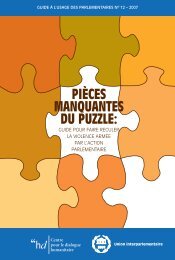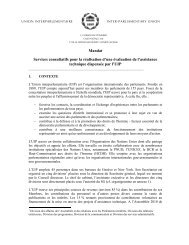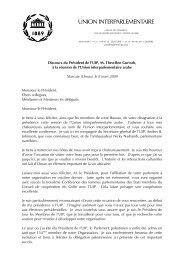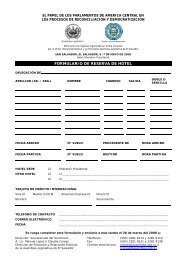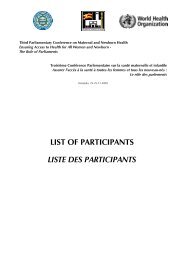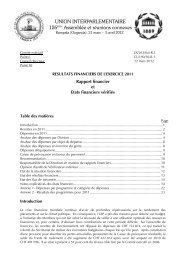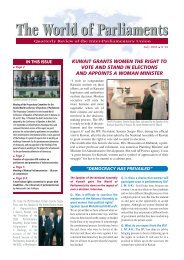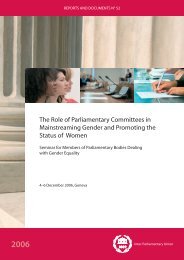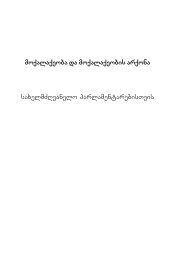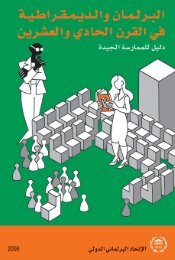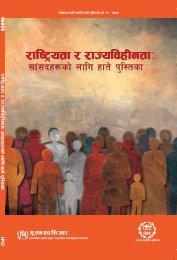MISSING PIECES - Inter-Parliamentary Union
MISSING PIECES - Inter-Parliamentary Union
MISSING PIECES - Inter-Parliamentary Union
You also want an ePaper? Increase the reach of your titles
YUMPU automatically turns print PDFs into web optimized ePapers that Google loves.
<strong>MISSING</strong> <strong>PIECES</strong><br />
Those devising policy and programmes often speak exclusively to men<br />
about finding solutions to security problems, from how to undertake disarmament<br />
and weapons control to the need to find alternatives to oppressive<br />
policing. Planners often fail to consider the implications of the roles<br />
of men and women, and boys and girls, in fighting forces; do not design<br />
consultation processes to involve women, children and youth; or poorly<br />
recognise existing anti-violence activities usually led by women. The genderblind<br />
approach has entrenched the misconceived notion that women have<br />
no interest in, knowledge about, or influence over attitudes to gun use and<br />
possession, or disarmament.<br />
I know some [organisations] that deal with former combatant boys.<br />
They help to rehabilitate them, send them to school, help them to be<br />
engineers, teachers, whatever [they] want to be. They provide food,<br />
clothing, [and] medical facilities. But I don’t know of any kind of<br />
rehabilitation centres for women. Most of the women only tell their<br />
friends [that they were combatants]. You hardly find women combatants<br />
saying that the government should try to help them.<br />
—Agnes from Liberia 38<br />
Sierra Leone provides an example of the impacts of this failure. While<br />
the UN Mission in Sierra Leone (UNAMSIL) was initially praised as ‘a<br />
success and a model for [a] robust and successful mandate that moved<br />
from peacekeeping to sustainable peace building’, for ‘a successful disarmament<br />
and demobilisation programme’, and for its ongoing work in reintegration,<br />
the mission is now known to have initially failed women and<br />
girls involved in fighting forces. 39 Determining who qualified to join the<br />
programme was a complex process, which UNAMSIL tackled by collecting<br />
basic information from combatants that included identifying the person’s<br />
commander, a test in which a weapon was dismantled and reassembled,<br />
and strict guidelines on what qualified as a weapon. Eligibility requirements<br />
almost guaranteed the exclusion of females, especially girls, who were<br />
rarely eligible for the ‘one person, one weapon’ approach. The results of<br />
this approach are difficult to assess because reliable figures are unavailable,<br />
but one estimate suggests that while at least 10,000 women are thought to<br />
have been associated with armed groups, of the 72,490 demobilised adult<br />
combatants, only 4,751 were women; and of the 6,787 children, a mere 506<br />
(7.46 per cent) were girls. 40<br />
88



